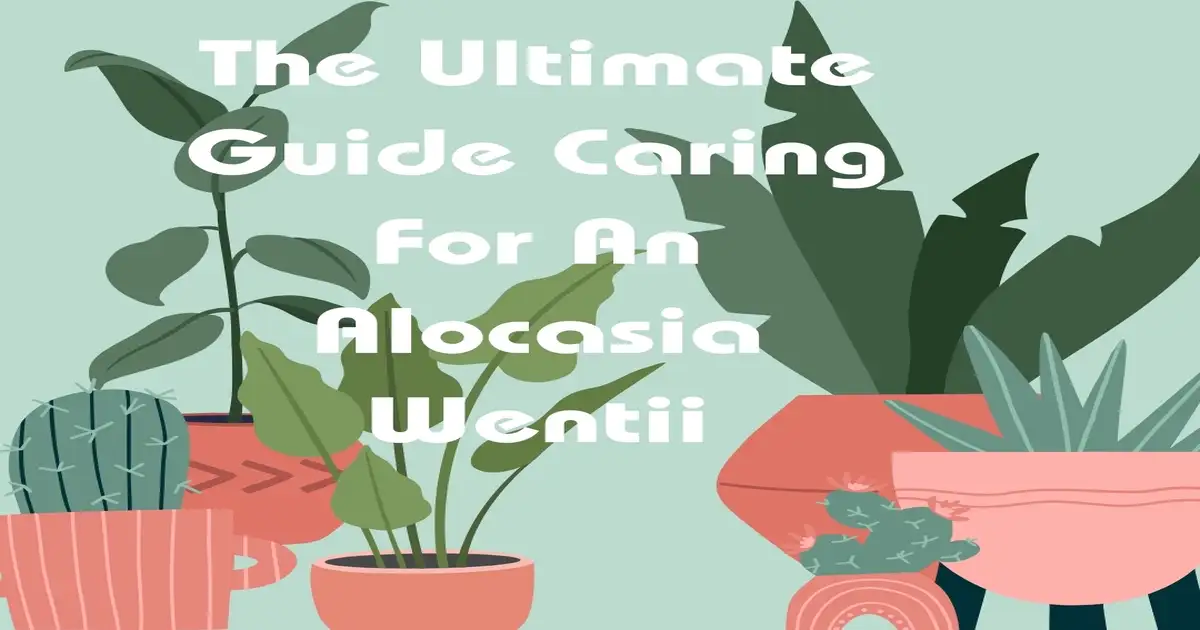Alocasia Wentii is popular among plant lovers due to its large, beautiful leaves and purple-green shade. It is also known as the New Guinea Shield or Hardy Elephant’s Ear. However, it has a very particular care routine that must be followed to grow well indoors and outdoors. Whether you are an experienced gardener or just starting to discover the world of plants, this blog will help you take care of your Alocasia Wentii.
Table of Contents
1. Introduction
The first step in creating an appropriate care environment for any plant is understanding its origin and general characteristics. This alocasia variety comes from the Highlands region in Papua New Guinea, where it grows at high altitudes with low temperatures most of the year. Its leaves are big and shaped like arrowheads, dark green on top and deep burgundy underneath them, but what should not be forgotten about this breed (as well as many others) is that they contain oxalic acid, which makes them poisonous for people and pets, thus require careful handling.
2. Light Needs for Alocasia Wentii
Alocasia needs bright but indirect light to thrive well since direct sunshine can cause sunburns on its leaves. Place your plant a few feet away from south-facing windows, or use transparent drapes as sunlight filters through them gently. If natural illumination is insufficient, consider using artificial lights; however, ensure that fixtures are not too close lest they scorch delicate foliage.
3. Watering Guide for Alocasia Wentii
Watering an Alocasia Wentii requires specific needs because although it loves moisture, too much water can cause root rot. It needs consistently moist soil but not wet or soggy; therefore, never allow the soil to dry out completely. The watering frequency should be around once a week if kept indoors, adjusting this according to humidity levels in your home throughout different seasons.
4. Soil Preferences for Alocasia Wentii
The soil that Alocasia Wentii thrives best in drains that have high nutrient content, too. A good mix would include peat moss, pine bark fines and perlite; all these will help hold onto some moisture while allowing enough air circulation around the roots. Avoid using compacted soils as they can hinder proper root development.
5. Humidity Needs of Alocasia Wentii
Alocasia Wentii loves high humidity because it replicates its natural tropical environment in New Guinea, where it originated. The more moist you keep the plant’s surroundings, the better it grows, so misting can be done frequently, especially during hot, dry weather spells or when indoor heating tends to make everything very dry. Grouping different plants also increases humidity naturally within confined spaces such as living rooms or offices. Still, if necessary, an electric humidifier may need to be used, keeping relative humidity between 60% – 80%.
6. Fertilizing Alocasia Wentii
For healthy growth and maintenance of the elephant ear plant, feed it with a balanced liquid fertilizer every month during its growing season, which falls in spring and summer. A general-purpose water-soluble fertilizer mixed at half strength should do just fine to nourish your plant adequately.
7. Common Issues and Troubleshooting Tips
Yellow leaves are usually caused by overwatering or underwatering, low humidity levels nearby or wrong light exposure given to the plant. Brown tips on leaves could mean that either too little water is being supplied overall or tap water contains high chloride/ fluoride content; therefore, try using distilled water instead when watering or allow tap water to sit overnight before use.
Bacterial and fungal diseases may occur, especially when soils become waterlogged for long periods, and there is poor air circulation around the pot. To prevent such problems, ensure proper soil preparation, that drainage holes in pots are open, and that water is always at the base of the stem, not on top of leaves.
8. Alocasia Wentii: Indoors vs Outside Care
Choosing between indoors and outdoors for your Alocasia Wentii should be based on the temperature and humidity levels that would best suit it. It can still do well when grown as an indoor plant, but some climates may offer conditions for outdoor growing instead. Just ensure the place outside is shielded from strong winds, which could damage its delicate leaves.
9. Propagation and Repotting Tips
Divide and repot your Alocasia Wentii every 2-3 years to rejuvenate it; this allows the plant to spread and gives it fresh, nutrient-rich soil. You can also use this time to propagate your plant by separating its tuber and putting it in new moist soil where it will sprout into a new Alocasia Wentii family tree.
Ensure the new pot has good drainage holes to avoid root rot problems. Also, post-care light and humidity requirements should be followed strictly after repotting to support new growth.
10. Integrate Alocasia Wentii into Your Home Decor
With its attention-grabbing sturdy leaves and unique color scheme, Alocasia Wentii can be an outstanding statement piece in any home decor setting. Pair it with other plants for a lush tropical atmosphere, or let it stand alone as a focal point. Additionally, the plant likes to be moved around infrequently, so choose its location wisely since you might have to settle in one place for a while.
Conclusion
Following this complete Alocasia Wentii care guide, your plant will thrive in your house while living a long, healthy life. Remember that plants are living things that change with time; therefore, do not hesitate to adjust how you care for them as they grow into bigger sizes than we expected. Have patience, be keen, and, more importantly, have fun taking care of these beauties from the highlands of New Guinea.

